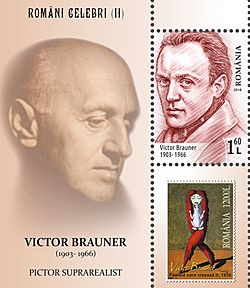Victor Brauner facts for kids
Quick facts for kids
Victor Brauner
|
|
|---|---|

Brauner and his work on a 2018 stamp sheet
|
|
| Born | 15 June 1903 |
| Died | 12 March 1966 (aged 62) |
| Resting place | Montmartre Cemetery, Paris |
| Nationality | Romanian, French (since 1963) |
| Education | Bucharest National University of Arts |
| Movement | Surrealism |
Victor Brauner (1903–1966) was a famous Romanian painter and sculptor. He was known for his unique style, which was part of the Surrealist art movement. Surrealism was an art style that explored dreams and imagination.
Contents
Early Life and Art Beginnings
Victor Brauner was born on June 15, 1903, in Piatra Neamț, Romania. His father was a timber manufacturer. For a few years, Victor and his family lived in Vienna, where he went to elementary school. When they returned to Romania in 1914, he continued his studies. At that time, he was very interested in zoology, which is the study of animals.
Victor later studied art at the National School of Fine Arts in Bucharest from 1916 to 1918. He also attended a private painting school. He started by painting landscapes, which are pictures of nature. He then explored many different art styles, including Dadaist (art that challenged traditional ideas), Abstractionist (art that uses shapes and colors instead of realistic images), and Expressionist (art that shows strong feelings).
On September 26, 1924, Victor had his first art show in Bucharest. Around this time, he met a poet named Ilarie Voronca. Together, they started a magazine called 75HP. In this magazine, Brauner shared his ideas about art, including something he called The Pictopoetry and The Surrationalism. He painted interesting works like Christ at the Cabaret and The Girl in the Factory.
Moving to Paris and Surrealism
In 1925, Victor Brauner traveled to Paris, France, for the first time. He returned to Romania in 1927. From 1928 to 1931, he contributed to a magazine called unu. This magazine was known for its avant-garde (new and experimental) ideas, especially those related to Dadaism and Surrealism. The magazine showed many of Brauner's drawings and paintings.
In 1930, Victor Brauner moved to Paris for good. There, he met the famous sculptor Constantin Brâncuși, who taught him about art photography. He also became friends with the Romanian poet Benjamin Fondane and met Yves Tanguy. Tanguy later introduced Brauner to a group of artists known as the Surrealists. These artists were interested in dreams, the unconscious mind, and strange, unexpected images.
Brauner lived in the same building as other artists like Alberto Giacometti and Tanguy. During this time, he painted a famous work called Self-portrait with enucleated eye. This painting showed him with one eye removed. It was a strange image that seemed to predict something that would happen to him later.
In 1934, the famous Surrealist leader André Breton wrote an introduction for Brauner's first solo art show in Paris. Breton noticed that the theme of the eye was very important in Brauner's paintings, like Mr. K's power of concentration.
Returning to Romania and Later Years
In 1935, Brauner went back to Bucharest. He had another art show where he displayed 16 paintings. He also created illustrations for poetry books by Gellu Naum.
In 1938, Brauner returned to France. A very unusual and sad event happened to him that year. During an argument between two other artists, Oscar Domínguez and Esteban Francés, Brauner tried to help Esteban. He was hit by a glass thrown by Domínguez and lost his left eye. This made his earlier painting, Self-portrait with enucleated eye, seem like a strange prediction.
After this, he met Jaqueline Abraham, who later became his wife. He started painting a series of works that showed creatures that were part human and part animal, sometimes called lycanthropic or chimeras.
When Nazi Germany invaded France in 1940, Brauner left Paris to stay safe. He lived in different places in the south of France, sometimes being forced to stay in one area. However, he managed to keep in touch with other Surrealist artists who had also moved to Marseille. In 1941, he was allowed to settle in Marseille, but he became very ill and had to go to the hospital.
After World War II, Brauner continued to paint. He took part in the Venice Biennale, a big art exhibition in Italy. In 1954, he painted Prelude to a civilization, which is now in the Metropolitan Museum of Art in New York.
In 1959, he moved into a studio in Montmartre, a famous artistic area in Paris. He also spent a lot of time working in Varengeville in Normandy. In 1961, he had a solo exhibition of his work in New York City.
In 1965, Brauner created a group of art pieces called Mythologie and Fêtes des mères. His very last painting, made in 1965, was called La fin et le début (The End and the Beginning). This painting reminds us that when an artist's life ends, their artwork continues to live on.
In 1966, Victor Brauner was chosen to represent France at the Venice Biennale, where a whole room was dedicated to showing his art.
Victor Brauner died in Paris on March 12, 1966, after a long illness. He is buried in Montmartre Cemetery. On his tombstone, there is a quote from his notebooks: "Painting is life, real life, my life." This shows how much art meant to him.
His private notes, which he kept in notebooks, help us understand his art better. He once wrote, "Each painting that I make is projected from the deepest sources of my anxiety..."
Victor Brauner's brother, Harry Brauner, was a folklorist, someone who studies traditional stories and customs.
See also
 In Spanish: Victor Brauner para niños
In Spanish: Victor Brauner para niños
- Bodley Gallery
- Transatlantic (a TV series from 2023 that shows a character based on him)


